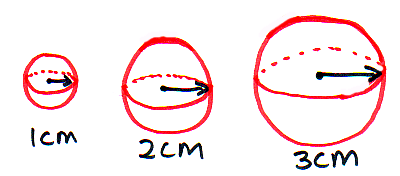Cubes, spheres and the shape of all things
So, using both normal and log-transformed data, we find that, when measuring cubes, surface area scales to volume with a 2/3 power rule.
OK, OK, we know what you're thinking. That's fine for cubes, but most organisms aren't shaped like cubes! In fact, the only organism we could think of that is shaped rather cube-like is Spongebob Squarepants!

We'd like to believe that this relationship extends beyond the world of Spongebob - so do we have to figure out how each organism is shaped, then figure out the specific surface to volume ratio? That sounds like a lot of work! Last time we checked, there were already 1.4 million species described with up to another 30 million to go! How the heck are we going to figure out all those geometric relationships!?!
Hopefully, there is some consistency in how surface area to volume scales for different shapes. Let's try another shape. How about the scaling relationship as a sphere increases in size (from 1 to 2 to 3 cm in radius).

Let's do the same thing we did with the cube, figure out the surface area and volume of each of these three spheres, then figure out the values of the parameters "b" and "a". We won't ask you to figure these quantities out, since only the mathiest of math-geeks would remember the formulas for the surface area and volume of a sphere (but here they are just in case you want to memorize them):
surface area = 4πr2
volume = (4/3)πr3
So here are the values for the three spheres:
|
|
|
|
| radius (cm) | 1cm |
2cm |
3cm |
| surface area (cm2) | 12.57 |
50.27 |
113.1 |
| volume (cm3) | 4.19 |
33.51 |
113.1 |
| surface area/volume ratio | 3 |
1.5 |
1 |
Notice that, as with cubes, surface area to volume decreases as the size of the sphere increases. But, more importantly, how do you think that surface area will scale to volume for spheres?
Copyright University of Maryland, 2007
You may link to this site for educational purposes.
Please do not copy without permission
requests/questions/feedback email: mathbench@umd.edu